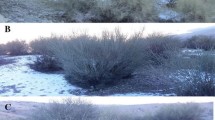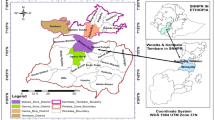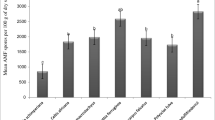Abstract
Most studies on bamboo have evaluated their commercial use but few have investigated their associated arbuscular mycorrhizal fungi (AMF). These symbiont fungi are fundamental on plant growth, nutrient cycling, biodiversity maintenance, etc., particularly on acidic/dystrophic soils as those of the Brazilian Cerrado. This study aimed to characterize the community composition and ecological interactions of AMF associated with the bamboo species Actinocladum verticillatum and Bambusa vulgaris vittata, under Cerrado vegetation in central Brazil. Roots and rhizospheric soil samples of A. verticillatum and B. vulgaris vittata were collected on 12 plots in the Gurupi (Tocantis state) and Porangatu (Goiás state) microregions. The roots’ mycorrhizal colonization rate, rhizospheric soil’ spore density, and the associated AMF genera were evaluated. There were no differences in the radical mycorrhizal colonization rates among the two bamboo species, although B. vulgaris vittata showed higher spore density than A. verticillatum. The genera Acaulospora, Claroideglomus, Diversispora, Scutellospora, Glomus, and Gigaspora were identified in both bamboo species, while Sclerocystis was present only on A. verticillatum. The genera Acaulospora, Diversispora, and Glomus were frequently found together. This study may be a first step to future AMF-based bamboo micro-propagation efforts in the Cerrado Brazilian vegetation.




Similar content being viewed by others
References
Aguilera P, Marín C, Oehl F, Godoy R, Borie F, Cornejo PE (2017) Selection of aluminum tolerant cereal genotypes strongly influences the arbuscular mycorrhizal fungal communities in an acidic Andosol. Agric Ecosyst Environ 246:86–93
Almeida RT, Schenck NC (1990) A revision of the genus Sclerocystis (Glomaceae, Glomales). Mycologia 82:703–714
Błaszkowski J (2012) Glomeromycota. W. Szafer Institute of Botany, Polish Academy of Sciences, Kraków
Błaszkowski J, Furrazola E, Chwat G, Góralska A, Lukács AF, Kovács GM (2015) Three new arbuscular mycorrhizal Diversispora species in Glomeromycota. Mycol Prog 14:105
Brundrett MC, Tedersoo L (2018) Evolutionary history of mycorrhizal symbioses and global host plant diversity. New Phytol 220:1108–1115
Bueno CG, Marín C, Silva-Flores P, Aguilera P, Godoy R (2017) Think globally, research locally: contrasting patterns of mycorrhizal symbiosis in South America. New Phytol 215:1306–1309
Bystriakova N, Kapos V, Lysenko I (2004) Bamboo biodiversity: Africa, Madagascar and the Americas (no. 19). United Nations Environmental Program, Nairobi
Chen YH, Chang CC, Chang CY, Yuan MH, Ji DR, Shie JL, Lee CH, Chen YH, Chang WR, Yang TY, Hsu TC, Huang M, Wu CH, Lin FC, Ko CH (2017) Production of a solid bio-fuel from waste bamboo chopsticks by torrefaction for cofiring with coal. J Anal Appl Pyrolysis 126:315–322
Das P, Kayang H (2010) Arbuscular mycorrhizal fungi and dark septate endophyte colonization in bamboo from Northeast India. Front Agric China 4:375–382
Davison J, Moora M, Öpik M, Adholeya A, Ainsaar L, Bâ A et al (2015) Global assessment of arbuscular mycorrhizal fungus diversity reveals very low endemism. Science 349:970–973
De Andrade Júnior JA, de Souza BR, Souza RF, de Moura JB (2018) Fixação de carbono em sistemas agroecológicos na região do Vale do São Patrício, Goiás. Científic@ - Multidiscip J 5:85–98
De Assis DMA, de Melo MAC, da Silva DKA, Oehl F, da Silva GA (2018) Assemblages of arbuscular mycorrhizal fungi in tropical humid and dry forests in the northeast of Brazil. Botany 96:859–871
De Moura JB, Valentim NM, Ventura MVA, Junior WGV (2018) Taxa de colonização micorrízica sob diferentes sistemas de cultivo no cerrado em cana-de-açúcar. Diálogos & Ciência 2:60–66
Eiten G (1972) The cerrado vegetation of Brazil. Bot Rev 38:201–341
França CDD (2011) Potencialidades de espécies de bambu para a estabilidade de encostas e áreas degradadas em solos do Cerrado. Master Thesis, Universidade de Brasília, Brazil
Gai JP, Christie P, Feng G, Li XL (2006) Twenty years of research on community composition and species distribution of arbuscular mycorrhizal fungi in China: a review. Mycorrhiza 16:229–239
Gemma JN, Koske RE, Carreiro M (1989) Seasonal dynamics of selected species of VA mycorrhizal fungi in a sand dune. Mycol Res 92:317–321
Gerdemann JW, Nicolson TH (1963) Spores of mycorrhizal Endogone species extracted from soil by wet sieving and decanting. Trans Br Mycol Soc 46:235–244
Giovannetti M, Mosse B (1980) An evaluation of techniques for measuring vesicular arbuscular mycorrhizal infection in roots. New Phytol 84:489–500
Hammer Ø (2018) Past 3.x - the Past of the Futur. University of Oslo, Oslo
Hawkes CV, Belnap J, D’Antonio C, Firestone MK (2006) Arbuscular mycorrhizal assemblages in native plant roots change in the presence of invasive exotic grasses. Plant Soil 281:369–380
INVAM (2018) International culture collection of (vesicular) arbuscular mycorrhizal fungi. West Virginia University, Morgantown
Jeffries P, Gianinazzi S, Perotto S, Turnau K, Barea JM (2003) The contribution of arbuscular mycorrhizal fungi in sustainable maintenance of plant health and soil fertility. Biol Fertil Soils 37:1–16
Jiang W, Gou G, Ding Y (2013) Influences of arbuscular mycorrhizal fungi on growth and mineral element absorption of chenglu hybrid bamboo seedlings. Pak J Bot 45:303–310
Johnson NC, Pfleger FL (1992) Vesicular-arbuscular mycorrhizae and cultural stresses. In: Bethlenfalvay GJ, Linderman RG (eds) Mycorrhizae in sustainable agriculture. American Society of Agronomy, Madison, pp 71–99
Klironomos JN (2003) Variation in plant response to native and exotic arbuscular mycorrhizal fungi. Ecology 84:2292–2301
Kong B (2017) Study of the microbial community structure in the rhizosphere of understory dwarf bamboo (Sasa kurilensis) in a Betula ermanii forest, northern Japan. Doctoral Thesis, Hokkaido University, Japan
Londoño X (1998) Evaluation of bamboo resources in Latin America. A summary of the final report of project 96-8300-01-4. International network for bamboo and rattan
Mafaziya F, Madawala S (2015) Abundance, richness and root colonization of arbuscular mycorrhizal fungi in natural and semi-natural land use types at upper Hantana. Ceylon J Sci (Biol Sci) 44:25–34
Maoyi F, Banik RL (1995) Bamboo production systems and their management. In: 50 international bamboo workshop and the 4 international bamboo congress: propagation and management. INBAR, Bali, pp 18–33
Marcuzzo FFN, Andrade LR, Melo DCDR (2011) Métodos de interpolação matemática no mapeamento de chuvas do estado do Mato Grosso. Rev Bras Geogr Fís 4:793–804
Marimon BS, Felfili JM, Lima EDS, Duarte WMG, Marimon-Júnior BH (2010) Environmental determinants for natural regeneration of gallery forest at the Cerrado/Amazonia boundaries in Brazil. Acta Amazon 40:107–118
Marín C, Bueno CG (2019) A systematic review on South American and European mycorrhizal research: is there a need for scientific symbiosis? In: Pagano M, Lugo M (eds) Mycorrhizal Fungi in South America. Springer, Chem, pp 97–110
Marín C, Aguilera P, Oehl F, Godoy R (2017) Factors affecting arbuscular mycorrhizal fungi of Chilean temperate rainforests. J Soil Sci Plant Nutr 17:966–984
Marín C, Valenzuela E, Godoy R, Palfner G (2018) Diversity and growth-effects of ectomycorrhizal fungi of a Nothofagus pumilio forest in the Andes of Southern Chile. Bol Micol 33:9–20
Marinho F, Oehl F, da Silva IR, Coyne D, da Nóbrega Veras JS, Maia LC (2019) High diversity of arbuscular mycorrhizal fungi in natural and anthropized sites of a Brazilian tropical dry forest (Caatinga). Fungal Ecol 40:82–91
Marulanda A, Azcon R, Ruiz-Lozano JM (2003) Contribution of six arbuscular mycorrhizal fungal isolates to water uptake by Lactuca sativa plants under drought stress. Physiol Plant 119:526–533
Muthukumar T, Udaiyan K (2000) Arbuscular mycorrhizas of plants growing in the Western Ghats region, southern India. Mycorrhiza 9:297–313
Muthukumar T, Udaiyan K (2006) Growth of nursery-grown bamboo inoculated with arbuscular mycorrhizal fungi and plant growth promoting rhizobacteria in two tropical soil typeswith and without fertilizer application. New For 31:469–485
Oehl F, Sieverding E, Palenzuela J, Ineichen K (2011) Advances in Glomeromycota taxonomy and classification. IMA Fungus 2:191–199
Oehl F, Laczko E, Oberholzer HR, Jansa J, Egli S (2017) Diversity and biogeography of arbuscular mycorrhizal fungi in agricultural soils. Biol Fertil Soils 53:777–797
Phillips JM, Hayman DS (1970) Improved procedures for clearing roots and staining parasitic and vesicular-arbuscular mycorrhizal fungi for rapid assessment of infection. Trans Br Mycol Soc 55:158–161
QGIS Development Team (2013) QGIS geographic information system. Open Source Geospatial Foundation Project. http://qgis.osgeo.org. Accessed 15 May 2019
Santander C, Sanhueza M, Olave J, Borie F, Valentine A, Cornejo P (2019) Arbuscular mycorrhizal colonization promotes the tolerance to salt stress in lettuce plants through an efficient modification of ionic balance. J Soil Sci Plant Nutr 19:321–331
Santos LCL, Brito GHM (2018) Delimitação das áreas de preservação permanente na bacia hidrográfica do rio dos patos, go e identificação dos conflitos de uso de solo. Ipê Agron J 2:53–60
Sharma R, Rajak RC (2010) Evidence of antagonistic interactions between rhizosphere and mycorrhizal fungi associated with Dendrocalamus strictus (bamboo). J Yeast Fungal Res 1:112–117
Shirasuna R (2012) Bambus nativos (Poaceae: Bambusoideae) no Parque Estadual das Fontes do Ipiranga, São Paulo, Brasil. Master Thesis, Instituto de Botnica da Secretaria de Estado do Meio Ambiente, São Paulo
Silva-Flores P, Bueno CG, Neira J, Palfner G (2019) Factors affecting arbuscular mycorrhizal fungi spore density in the Chilean Mediterranean-type ecosystem. J Soil Sci Plant Nutr 19:42–50
Singh S (2002) Mass production of AM fungi: part 1. Mycorrhiza News 14:2–10
Soderstrom TR (1981) Observations on a fire-adapted bamboo of the Brazilian cerrado, Actinocladum verticillatum (Poaceae: Bambusoideae). Am J Bot 68:1200–1211
Souza BR, Moura JB, Oliveira TC, Ramos MLG, Lopes Filho LC (2016) Arbuscular mycorrhizal fungi as indicative of soil quality in conservation systems in the region of vale do São Patrício, Goiás. Int J Curr Res 8:43307–43311
Van Dam JE, Elbersen HW, Montaño CMD (2018) Bamboo production for industrial utilization. In: Alexopoulou E (ed) Perennial grasses for bioenergy and bioproducts. Academic, New York, pp 175–216
Van Der Heijden MG, Martin FM, Selosse MA, Sanders IR (2015) Mycorrhizal ecology and evolution: the past, the present, and the future. New Phytol 205:1406–1423
Ventura MVA, de Moura JB, de Souza RF, Junior WGV, Rocha ECV, Silva JC (2018) Influence of arbuscular mycorrhizal fungi in the establishment of pre-broken sugar cane. Poljoprivreda i Sumarstvo 64:149–157
Viana PL, Filgueiras TS, Clark LG (2013a) Cambajuva (Poaceae: Bambusoideae: Bambuseae: Arthrostylidiinae), a new woody bamboo genus from southern Brazil. Syst Bot 38:97–103
Viana PL, Filgueiras TS, Graciano-Ribeiro D (2013b) A new woody bamboo (Poaceae, Bambusoideae) from Central Brazil, Aulonemia xerophylla. Novon 22:371–377
Wu CG, Chen ZC (1986) The Endogonaceae of Taiwan I. A preliminary investigation on Endogonaceae of bamboo vegetation at Chi-Tou areas, central Taiwan. Taiwania 31:65–87
Zhang J, Jiang J, Tian G (2016) The potential of fertilizer management for reducing nitrous oxide emissions in the cleaner production of bamboo in China. J Clean Prod 112:2536–2544
Acknowledgments
Thanks to Maxilene Correa for the helpful comments regarding this manuscript.
Funding
This research was supported by the Evangelical Educational Association – AEE. C.M. was funded by the Universidad de O’Higgins posdoctoral research fund and by the Fondecyt Project No. 1190642 (Chilean Government).
Author information
Authors and Affiliations
Corresponding author
Ethics declarations
Conflict of Interest
The authors declare that they have no conflict of interest.
Additional information
Publisher’s Note
Springer Nature remains neutral with regard to jurisdictional claims in published maps and institutional affiliations.
Rights and permissions
About this article
Cite this article
de Moura, J.B., de Souza, R.F., Junior, W.G.V. et al. Arbuscular Mycorrhizal Fungi Associated with Bamboo Under Cerrado Brazilian Vegetation. J Soil Sci Plant Nutr 19, 954–962 (2019). https://doi.org/10.1007/s42729-019-00093-0
Received:
Accepted:
Published:
Issue Date:
DOI: https://doi.org/10.1007/s42729-019-00093-0




